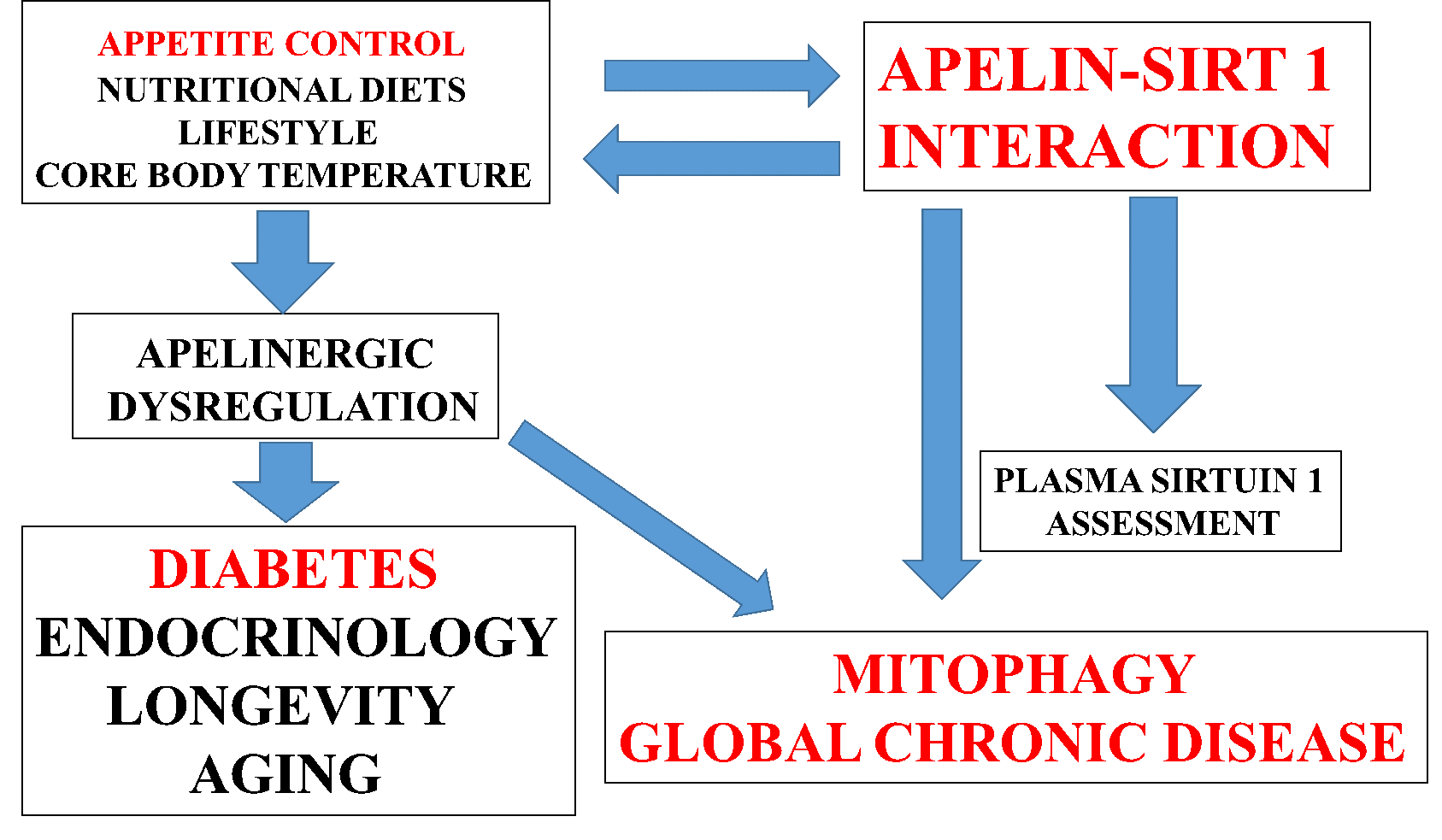apelinergic, appetite control, apelin, sirtuin 1, nutritional therapy, global, mitophagy, aging, diabetes, chronic disease
The apelinergic system and its relevance to endocrinology and diabetes has become of major importance to the global chronic disease epidemic. Apelinergic dysregulation is associated with appetite dysregulation [1] and connected to insulin resistance and various organ diseases that include the heart, adipose tissue, liver and the brain. The peptide apelin and its receptor APJ (G protein-coupled receptor) play an important role in various tissues and the role in stress, insulin resistance, hormone release, thermoregulation, food intake and water balance are critical to endocrinology and diabetes (Figure 1). Recent studies have indicated that apelin is now identified as an anti-aging factor and its inactivation leads to a decline in the apelinergic axis [2] with accelerated aging and programmed cell death that is linked to endocrinology, diabetes and neurodegenerative disease with relevance to the global chronic disease epidemic [3–6]. Apelin regulates the aging process by interactions with sirtuins [3] and its regulation of sirtuins 1-7 is critical in the prevention of the accelerated aging process and chronic disease.

Figure 1: Appetite control, dietary interventions, lifestyles and core body temperature are linked to apelinergic dysregulation in endocrinology and diabetes with relevance to mitophagy and global chronic disease epidemic.
Sirtuin 1 (SIRT1) has now been identified as an anti-aging gene [7] and apelin dysregulation may lead to downregulation of the SIRT1 gene with accelerated programmed cell death. Apelin and SIRT1 are linked to the central co-ordination and homeostasis of the neuroendocrine system that are controlled by lifestyle, diet, external stressors and appetite dysregulation (apelin-SIRT1 defect) that may lead to the acceleration of the global chronic disease epidemic. The apelin- SIRT1 dysregulation is connected to nitric oxide disturbances that induce diabetes, endocrine, metabolic and mental disorders [1, 8, 9]. Regulation of SIRT1 is now critical to age related diseases and longevity control with SIRT1 regulation of mitochondrial apoptosis linked to endocrinology and global chronic disease [10–15]. Apelin regulation of sirtuins has now become of major research interest with apelin control of SIRT1 linked to the cellular SIRT2-7 with relevance to mitophagy and programmed cell death (Figure 1). The discovery of SIRT1 as the heat shock gene [16, 17] may now be relevant to apelin-SIRT1 role in thermoregulation and appetite control relevant to endocrinology and diabetes.
Nutritional regulation and appetite control are essential to maintain the apelinergic axis and the apelin-SIRT1 interaction now relevant to the global chronic disease epidemic. Activators and inhibitors [18] of SIRT1 should be carefully assessed with relevance to apelinergic activation and dysregulation of the aging process and longevity. The release of the anti-aging protein SIRT1 in the blood plasma [19] should be assessed to determine an intact apelinergic axis with relevance to apelin and its role as an anti-aging factor in endocrinology and diabetes (Figure 1). Nutritional diets are associated with apelin-SIRT1 regulation of amyloid beta metabolism [1, 20, 21] that are connected to the anti-aging processes and Alzheimer’s disease with food quality critical to maintain the apelin-SIRT1 interaction and the prevention of Alzheimer’s disease and neurological diseases [22].
This work was supported by grants from Edith Cowan University, the McCusker Alzheimer’s Research Foundation and the National Health and Medical Research Council.

